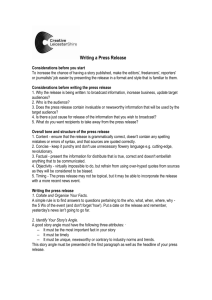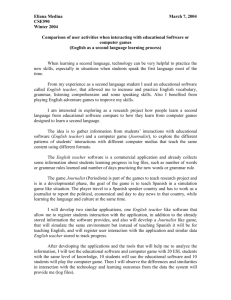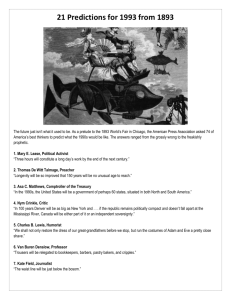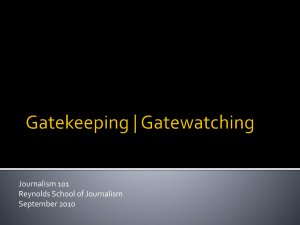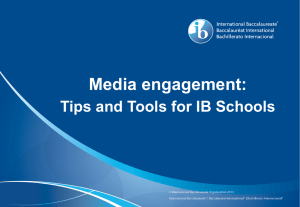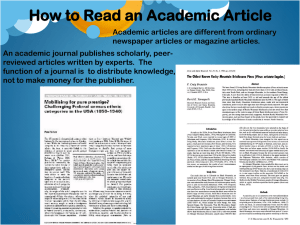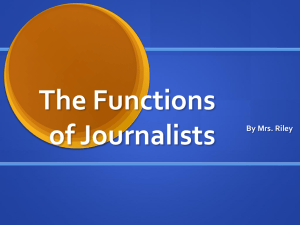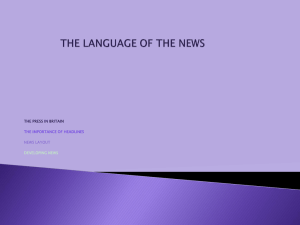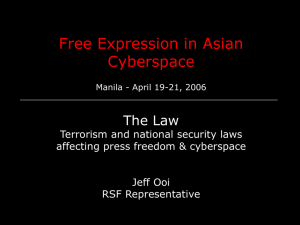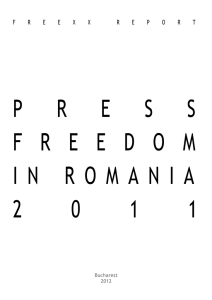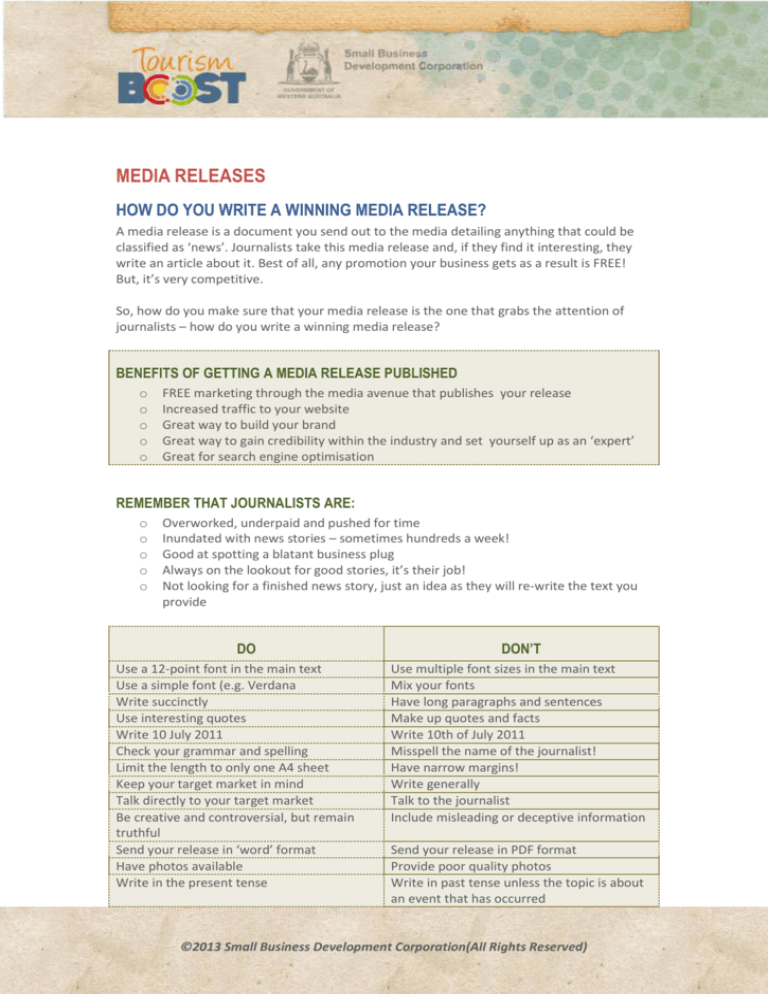
MEDIA RELEASES
HOW DO YOU WRITE A WINNING MEDIA RELEASE?
A media release is a document you send out to the media detailing anything that could be
classified as ‘news’. Journalists take this media release and, if they find it interesting, they
write an article about it. Best of all, any promotion your business gets as a result is FREE!
But, it’s very competitive.
So, how do you make sure that your media release is the one that grabs the attention of
journalists – how do you write a winning media release?
BENEFITS OF GETTING A MEDIA RELEASE PUBLISHED
o
o
o
o
o
FREE marketing through the media avenue that publishes your release
Increased traffic to your website
Great way to build your brand
Great way to gain credibility within the industry and set yourself up as an ‘expert’
Great for search engine optimisation
REMEMBER THAT JOURNALISTS ARE:
o
o
o
o
o
Overworked, underpaid and pushed for time
Inundated with news stories – sometimes hundreds a week!
Good at spotting a blatant business plug
Always on the lookout for good stories, it’s their job!
Not looking for a finished news story, just an idea as they will re-write the text you
provide
DO
Use a 12-point font in the main text
Use a simple font (e.g. Verdana
Write succinctly
Use interesting quotes
Write 10 July 2011
Check your grammar and spelling
Limit the length to only one A4 sheet
Keep your target market in mind
Talk directly to your target market
Be creative and controversial, but remain
truthful
Send your release in ‘word’ format
Have photos available
Write in the present tense
DON’T
Use multiple font sizes in the main text
Mix your fonts
Have long paragraphs and sentences
Make up quotes and facts
Write 10th of July 2011
Misspell the name of the journalist!
Have narrow margins!
Write generally
Talk to the journalist
Include misleading or deceptive information
Send your release in PDF format
Provide poor quality photos
Write in past tense unless the topic is about
an event that has occurred
©2013 Small Business Development Corporation(All Rights Reserved)
THE PYRAMID APPROACH
When writing a media release you need to adopt
the inverted ‘pyramid approach’. This basically
means that the first one or two paragraphs must
contain the most valuable information.
The reason for the inverted pyramid is that
journalists often chop from the bottom up.
Therefore, if you write the most important details
at the end of your release, you risk losing or
misinforming your reader.
A WINNING MEDIA RELEASE IN 8 EASY STEPS
STEP 1 – DETERMINE WHAT YOU ARE GOING TO WRITE ABOUT
When deciding what to write about, keep the following in mind:
o Why is this story going to interest the media?
o Is there a ‘feel good’ element to your story?
o Does your story:
o Evoke an emotional response?
o Relate to a key economic or social issue?
o Benefit or help others?
MEDIA RELEASE EXAMPLES
Business
What NOT to write
A winning story angle
Bus Tour
Company
B&B
Tip Top Bus Company adds five
luxury coaches to fleet.
Happy Days B&B welcomes
visitors from China.
The Best Cafe has a brand new
menu.
Aussie Souvenir House
announces new online store.
Perth’s corporate ‘boom’ attracts a new
type of luxury traveller.
Local tourism operators prepare for
possible Chinese influx.
Perth vs Melbourne! Local cafes cash in
on our gourmet love affair.
Local retailers recognise the shift in
consumer behaviour and go online.
Cafe
Retail
Souvenir
shop
©2013 Small Business Development Corporation(All Rights Reserved)
STEP 2 – WRITE A CATCHY HEADLINE FOR YOUR MEDIA RELEASE
The headline is the most important part of your media release; it must instantly grab the
attention of the journalist. Here are some tips:
o Keep your headline short, just one line.
o Make it an active and exciting headline, not static.
o Think of the questions outlined in step one when writing your headline.
o Make it bolder than the rest of the text so that it stands out.
STEP 3 – WRITE AN ATTENTION GRABBING FIRST PARAGRAPH
You should start with a strong, compelling first paragraph. Journalists get so many media
releases every day - you only have a few seconds to grab their attention.
Here are some tips:
o Keep succinct - save the detail for later in the media release.
o Explain and summarise the who, what, where, why, when and how - no more than
four or five lines.
o Tell the juiciest bits of your story here - grab the attention of the journalist.
o Try not to mention the name of your business - this will turn the journalist off.
Remember, you are selling the idea of your story, not your business.
STEP 4 – WRITE THE BODY OF THE MEDIA RELEASE
This is where you expand on your story and give it a bit of depth, backing up claims with
quotes and facts.
Here are some tips:
o Don’t be afraid to use dot points - they can be very powerful and handy for a
journalist to use.
o Remember not to save the best for last - it might never get read.
o Quotes are great – they add human element and credibility,
o Be honest and stick to the facts – no one likes outlandish claims.
o Highlight the benefit to the reader – perhaps use some ‘how to tips’.
o Supply a creative photo – add to the impact of having information published.
STEP 5 –WRITE YOUR CLOSING
This is where you ‘seal the deal’ with your position as the ‘expert’. Here are some tips:
o Keep it simple - short and to the point.
o First sentence - introduce an idea
Second/third sentence - support or expand on the idea
Final sentence - draws a conclusion or states why it is interesting or important.
Don’t give away your entire story - leave the reader wanting more.
Provide a brief overview of your business - give the journalist some background
information.
©2013 Small Business Development Corporation(All Rights Reserved)
STEP 6 – INCLUDE YOUR CONTACT DETAILS
Include your contact details in a separate box at the very bottom of the page.
Always mention "If you would like an interview with XXX please contact" - this lets the media
know you are available for interviews. Here are some tips:
o Make it easy for people to contact you - ensure there is an after-hours number.
o Fulfill any media requests for information within 12 hours -time is everything to
media.
STEP 7: SEND YOUR MEDIA RELEASE
As well as knowing how to write a media release, you also need to know who to send it to.
o What media organisations are you targeting?
o Is your story suited to regional, state, national or international audience?
o Who is going to be interested in your story?
Be sure to do some research and find out the name and direct email address of the most
appropriate person. Keep lists of publications/media sources that are suited to various
target markets and update them regularly.
When sending your media release, attach it in a word document and include the text in the
body of the email. Use the heading as your email subject line.
STEP 8: FOLLOW UP!
Always follow up with a phone call or email. It is wise to have supporting material on hand in
case the journalist needs more information.
To find out if your media release has been published anywhere you could sign up for Google
Alerts - If your media release has been published send the journalist a thank you note to let
them know how much you appreciate the support.
©2013 Small Business Development Corporation(All Rights Reserved)

